A Comprehensive Analysis of Leadership and Operations at Audi Company
VerifiedAdded on 2021/02/19
|13
|3296
|500
Report
AI Summary
This report delves into the core aspects of management and operation within the Audi company, focusing on their roles in converting raw materials into finished products or services to maximize profit and optimize resource utilization. It explores the importance of operational management in enhancing product quality and organizational efficiency. The report examines the roles and characteristics of leaders and managers, along with an analysis of leadership theories like situational, system, and contingency styles. Furthermore, it discusses various operational management approaches, including Total Quality Management, Just in Time, Six Sigma, and Continuous Improvement Process, and their impact on Audi's performance. The study also highlights the importance of operational management in making effective use of resources, improving product quality, and adapting to market trends. The report also covers process design and capacity management, emphasizing their significance in meeting customer demands and enhancing profitability. The report examines how Audi can adapt to the latest technologies to enhance its productivity, maintain customer satisfaction, and maintain its competitive edge within the market.
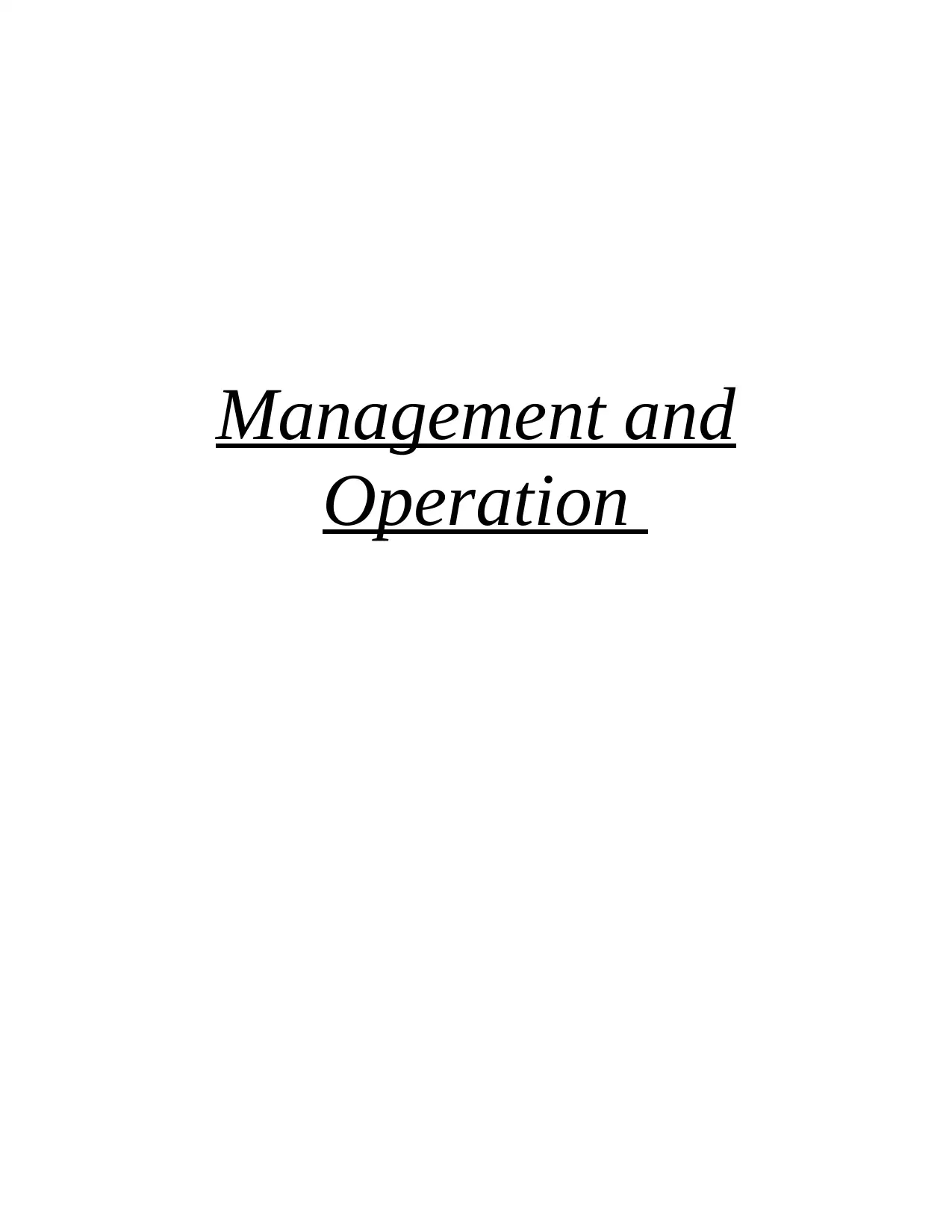
Management and
Operation
Operation
Paraphrase This Document
Need a fresh take? Get an instant paraphrase of this document with our AI Paraphraser
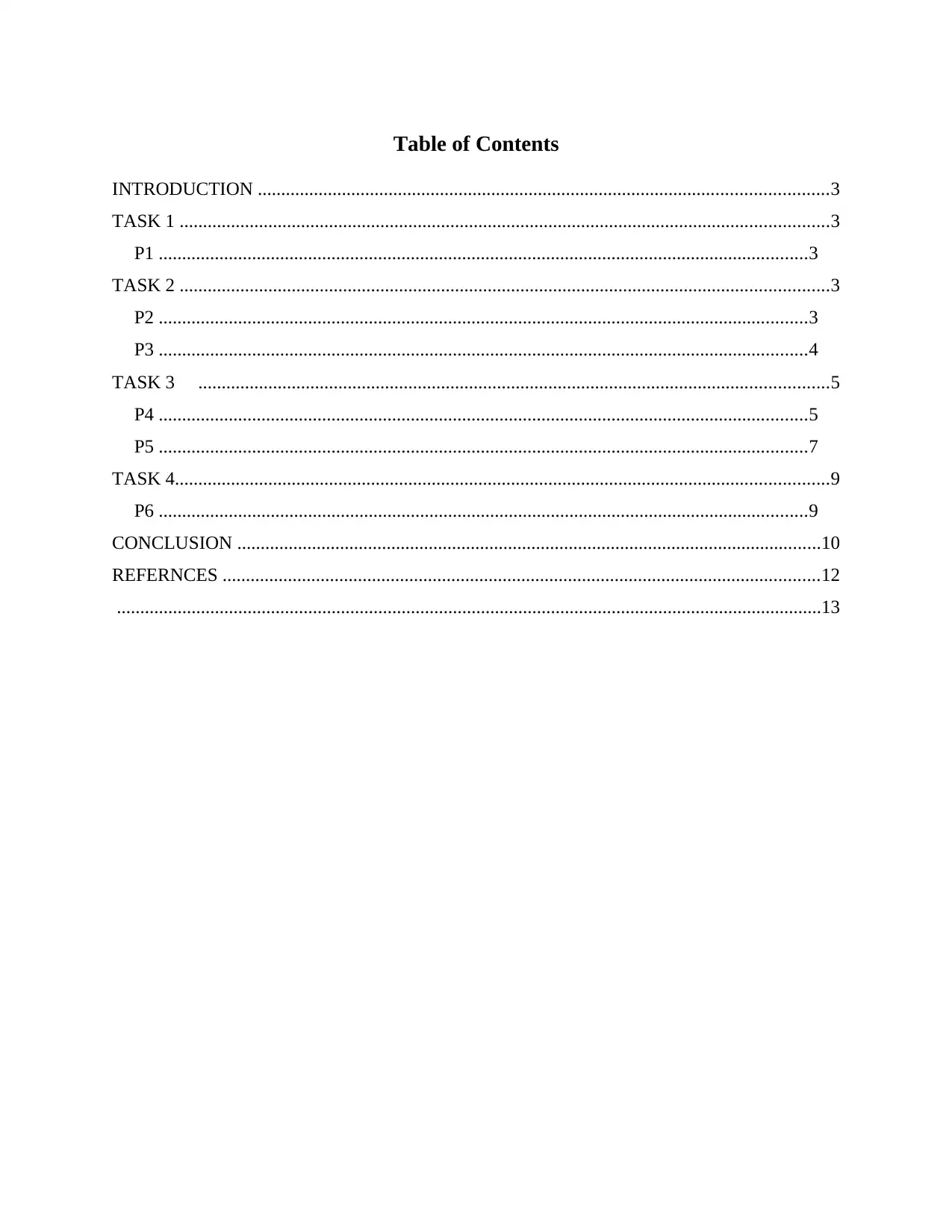
Table of Contents
INTRODUCTION ..........................................................................................................................3
TASK 1 ...........................................................................................................................................3
P1 ...........................................................................................................................................3
TASK 2 ...........................................................................................................................................3
P2 ...........................................................................................................................................3
P3 ...........................................................................................................................................4
TASK 3 .......................................................................................................................................5
P4 ...........................................................................................................................................5
P5 ...........................................................................................................................................7
TASK 4............................................................................................................................................9
P6 ...........................................................................................................................................9
CONCLUSION .............................................................................................................................10
REFERNCES ................................................................................................................................12
.......................................................................................................................................................13
INTRODUCTION ..........................................................................................................................3
TASK 1 ...........................................................................................................................................3
P1 ...........................................................................................................................................3
TASK 2 ...........................................................................................................................................3
P2 ...........................................................................................................................................3
P3 ...........................................................................................................................................4
TASK 3 .......................................................................................................................................5
P4 ...........................................................................................................................................5
P5 ...........................................................................................................................................7
TASK 4............................................................................................................................................9
P6 ...........................................................................................................................................9
CONCLUSION .............................................................................................................................10
REFERNCES ................................................................................................................................12
.......................................................................................................................................................13
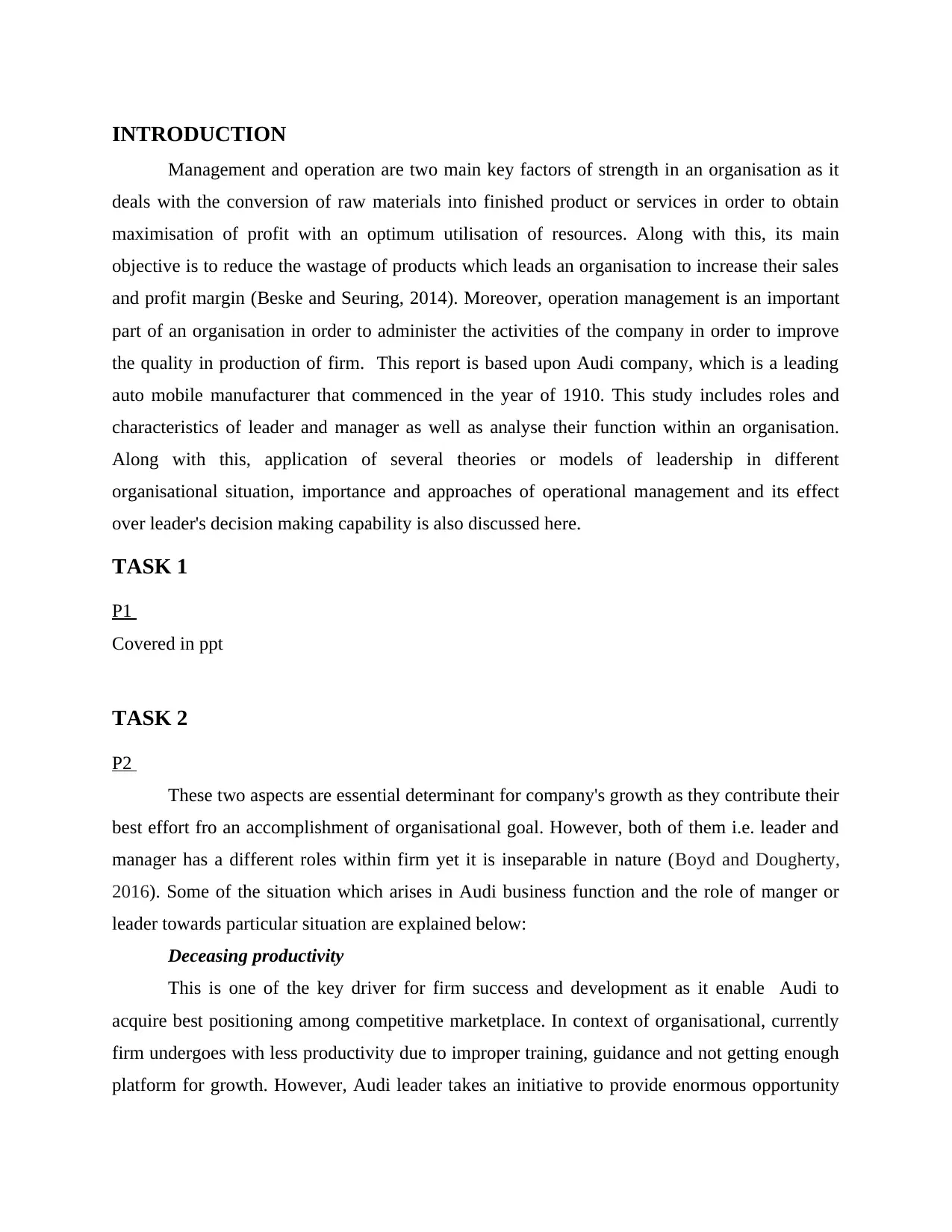
INTRODUCTION
Management and operation are two main key factors of strength in an organisation as it
deals with the conversion of raw materials into finished product or services in order to obtain
maximisation of profit with an optimum utilisation of resources. Along with this, its main
objective is to reduce the wastage of products which leads an organisation to increase their sales
and profit margin (Beske and Seuring, 2014). Moreover, operation management is an important
part of an organisation in order to administer the activities of the company in order to improve
the quality in production of firm. This report is based upon Audi company, which is a leading
auto mobile manufacturer that commenced in the year of 1910. This study includes roles and
characteristics of leader and manager as well as analyse their function within an organisation.
Along with this, application of several theories or models of leadership in different
organisational situation, importance and approaches of operational management and its effect
over leader's decision making capability is also discussed here.
TASK 1
P1
Covered in ppt
TASK 2
P2
These two aspects are essential determinant for company's growth as they contribute their
best effort fro an accomplishment of organisational goal. However, both of them i.e. leader and
manager has a different roles within firm yet it is inseparable in nature (Boyd and Dougherty,
2016). Some of the situation which arises in Audi business function and the role of manger or
leader towards particular situation are explained below:
Deceasing productivity
This is one of the key driver for firm success and development as it enable Audi to
acquire best positioning among competitive marketplace. In context of organisational, currently
firm undergoes with less productivity due to improper training, guidance and not getting enough
platform for growth. However, Audi leader takes an initiative to provide enormous opportunity
Management and operation are two main key factors of strength in an organisation as it
deals with the conversion of raw materials into finished product or services in order to obtain
maximisation of profit with an optimum utilisation of resources. Along with this, its main
objective is to reduce the wastage of products which leads an organisation to increase their sales
and profit margin (Beske and Seuring, 2014). Moreover, operation management is an important
part of an organisation in order to administer the activities of the company in order to improve
the quality in production of firm. This report is based upon Audi company, which is a leading
auto mobile manufacturer that commenced in the year of 1910. This study includes roles and
characteristics of leader and manager as well as analyse their function within an organisation.
Along with this, application of several theories or models of leadership in different
organisational situation, importance and approaches of operational management and its effect
over leader's decision making capability is also discussed here.
TASK 1
P1
Covered in ppt
TASK 2
P2
These two aspects are essential determinant for company's growth as they contribute their
best effort fro an accomplishment of organisational goal. However, both of them i.e. leader and
manager has a different roles within firm yet it is inseparable in nature (Boyd and Dougherty,
2016). Some of the situation which arises in Audi business function and the role of manger or
leader towards particular situation are explained below:
Deceasing productivity
This is one of the key driver for firm success and development as it enable Audi to
acquire best positioning among competitive marketplace. In context of organisational, currently
firm undergoes with less productivity due to improper training, guidance and not getting enough
platform for growth. However, Audi leader takes an initiative to provide enormous opportunity
⊘ This is a preview!⊘
Do you want full access?
Subscribe today to unlock all pages.

Trusted by 1+ million students worldwide
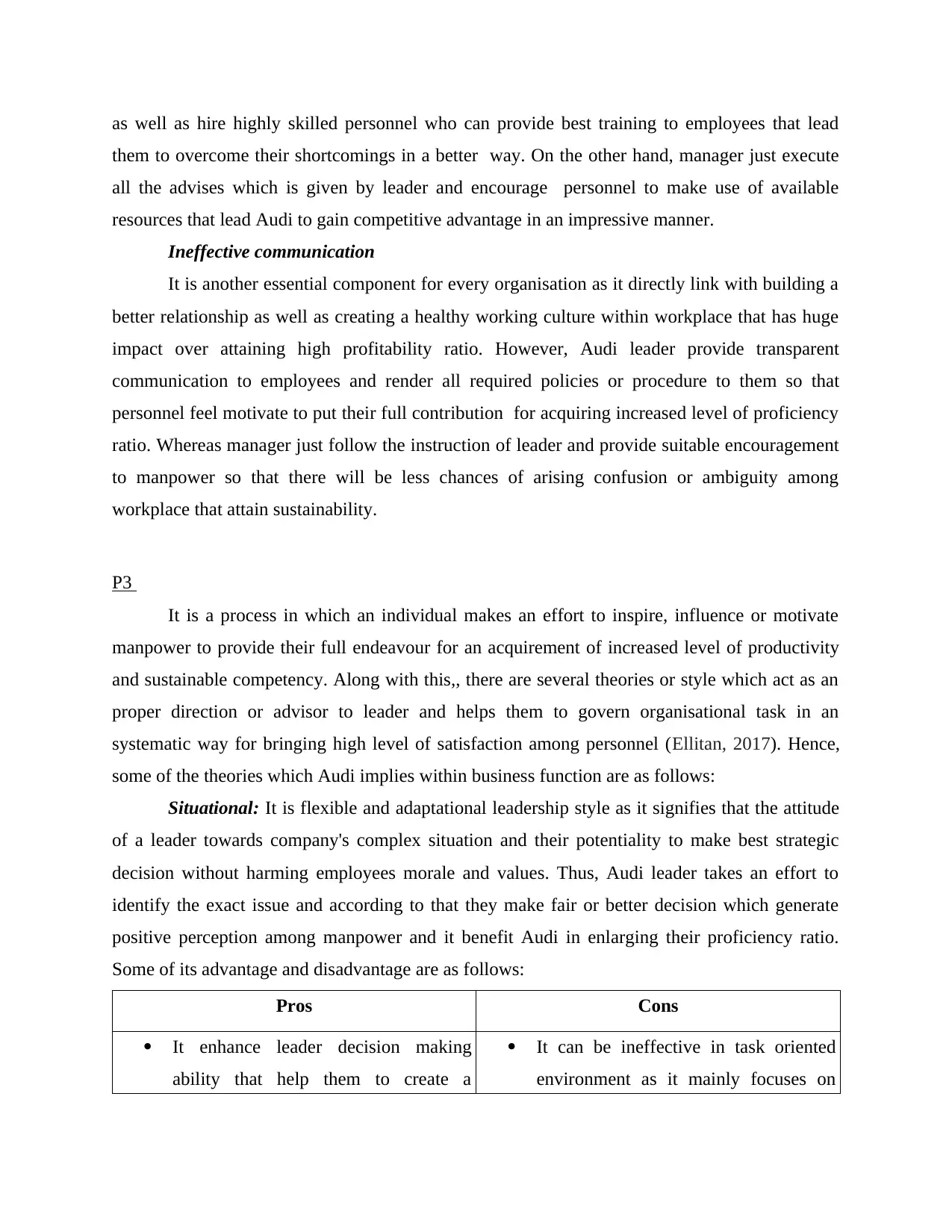
as well as hire highly skilled personnel who can provide best training to employees that lead
them to overcome their shortcomings in a better way. On the other hand, manager just execute
all the advises which is given by leader and encourage personnel to make use of available
resources that lead Audi to gain competitive advantage in an impressive manner.
Ineffective communication
It is another essential component for every organisation as it directly link with building a
better relationship as well as creating a healthy working culture within workplace that has huge
impact over attaining high profitability ratio. However, Audi leader provide transparent
communication to employees and render all required policies or procedure to them so that
personnel feel motivate to put their full contribution for acquiring increased level of proficiency
ratio. Whereas manager just follow the instruction of leader and provide suitable encouragement
to manpower so that there will be less chances of arising confusion or ambiguity among
workplace that attain sustainability.
P3
It is a process in which an individual makes an effort to inspire, influence or motivate
manpower to provide their full endeavour for an acquirement of increased level of productivity
and sustainable competency. Along with this,, there are several theories or style which act as an
proper direction or advisor to leader and helps them to govern organisational task in an
systematic way for bringing high level of satisfaction among personnel (Ellitan, 2017). Hence,
some of the theories which Audi implies within business function are as follows:
Situational: It is flexible and adaptational leadership style as it signifies that the attitude
of a leader towards company's complex situation and their potentiality to make best strategic
decision without harming employees morale and values. Thus, Audi leader takes an effort to
identify the exact issue and according to that they make fair or better decision which generate
positive perception among manpower and it benefit Audi in enlarging their proficiency ratio.
Some of its advantage and disadvantage are as follows:
Pros Cons
It enhance leader decision making
ability that help them to create a
It can be ineffective in task oriented
environment as it mainly focuses on
them to overcome their shortcomings in a better way. On the other hand, manager just execute
all the advises which is given by leader and encourage personnel to make use of available
resources that lead Audi to gain competitive advantage in an impressive manner.
Ineffective communication
It is another essential component for every organisation as it directly link with building a
better relationship as well as creating a healthy working culture within workplace that has huge
impact over attaining high profitability ratio. However, Audi leader provide transparent
communication to employees and render all required policies or procedure to them so that
personnel feel motivate to put their full contribution for acquiring increased level of proficiency
ratio. Whereas manager just follow the instruction of leader and provide suitable encouragement
to manpower so that there will be less chances of arising confusion or ambiguity among
workplace that attain sustainability.
P3
It is a process in which an individual makes an effort to inspire, influence or motivate
manpower to provide their full endeavour for an acquirement of increased level of productivity
and sustainable competency. Along with this,, there are several theories or style which act as an
proper direction or advisor to leader and helps them to govern organisational task in an
systematic way for bringing high level of satisfaction among personnel (Ellitan, 2017). Hence,
some of the theories which Audi implies within business function are as follows:
Situational: It is flexible and adaptational leadership style as it signifies that the attitude
of a leader towards company's complex situation and their potentiality to make best strategic
decision without harming employees morale and values. Thus, Audi leader takes an effort to
identify the exact issue and according to that they make fair or better decision which generate
positive perception among manpower and it benefit Audi in enlarging their proficiency ratio.
Some of its advantage and disadvantage are as follows:
Pros Cons
It enhance leader decision making
ability that help them to create a
It can be ineffective in task oriented
environment as it mainly focuses on
Paraphrase This Document
Need a fresh take? Get an instant paraphrase of this document with our AI Paraphraser
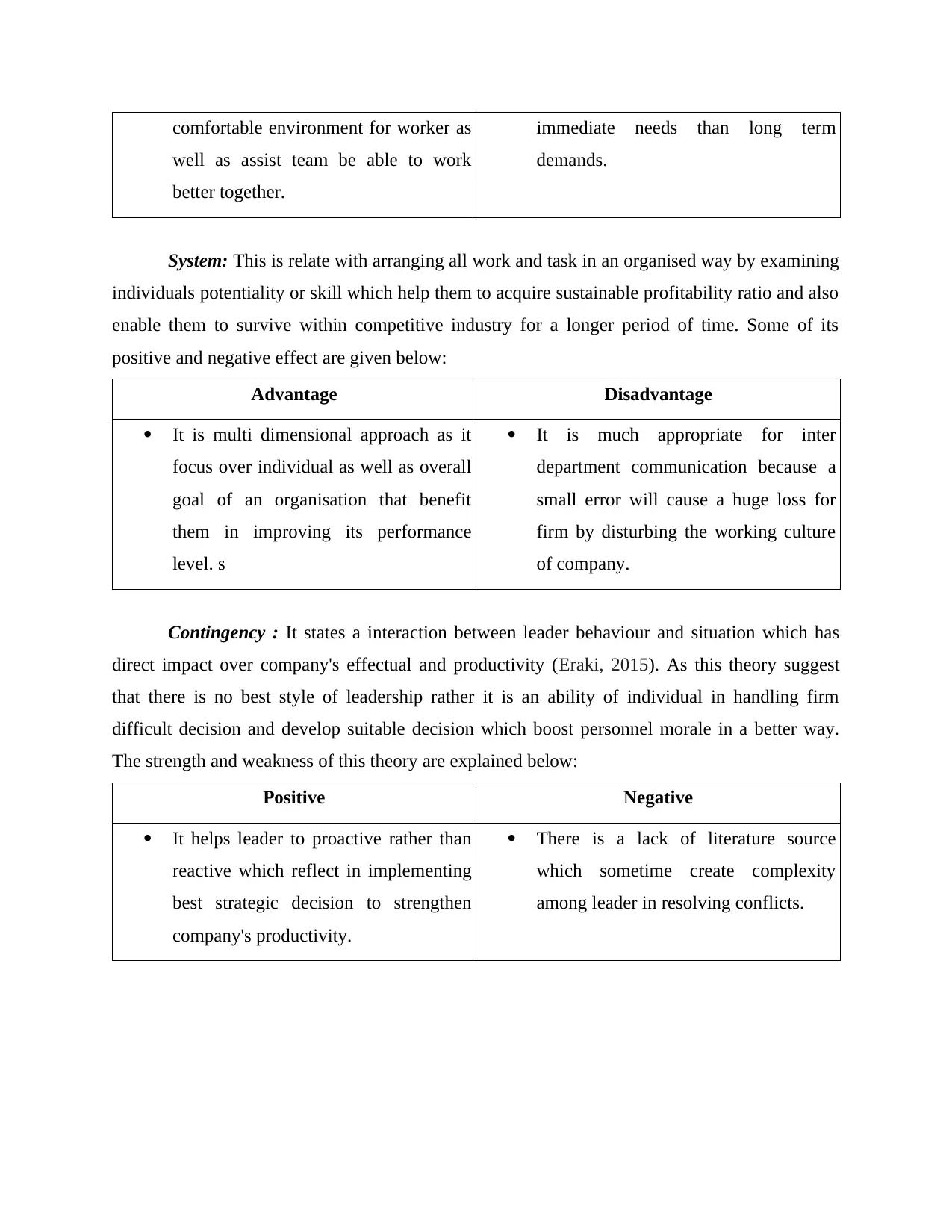
comfortable environment for worker as
well as assist team be able to work
better together.
immediate needs than long term
demands.
System: This is relate with arranging all work and task in an organised way by examining
individuals potentiality or skill which help them to acquire sustainable profitability ratio and also
enable them to survive within competitive industry for a longer period of time. Some of its
positive and negative effect are given below:
Advantage Disadvantage
It is multi dimensional approach as it
focus over individual as well as overall
goal of an organisation that benefit
them in improving its performance
level. s
It is much appropriate for inter
department communication because a
small error will cause a huge loss for
firm by disturbing the working culture
of company.
Contingency : It states a interaction between leader behaviour and situation which has
direct impact over company's effectual and productivity (Eraki, 2015). As this theory suggest
that there is no best style of leadership rather it is an ability of individual in handling firm
difficult decision and develop suitable decision which boost personnel morale in a better way.
The strength and weakness of this theory are explained below:
Positive Negative
It helps leader to proactive rather than
reactive which reflect in implementing
best strategic decision to strengthen
company's productivity.
There is a lack of literature source
which sometime create complexity
among leader in resolving conflicts.
well as assist team be able to work
better together.
immediate needs than long term
demands.
System: This is relate with arranging all work and task in an organised way by examining
individuals potentiality or skill which help them to acquire sustainable profitability ratio and also
enable them to survive within competitive industry for a longer period of time. Some of its
positive and negative effect are given below:
Advantage Disadvantage
It is multi dimensional approach as it
focus over individual as well as overall
goal of an organisation that benefit
them in improving its performance
level. s
It is much appropriate for inter
department communication because a
small error will cause a huge loss for
firm by disturbing the working culture
of company.
Contingency : It states a interaction between leader behaviour and situation which has
direct impact over company's effectual and productivity (Eraki, 2015). As this theory suggest
that there is no best style of leadership rather it is an ability of individual in handling firm
difficult decision and develop suitable decision which boost personnel morale in a better way.
The strength and weakness of this theory are explained below:
Positive Negative
It helps leader to proactive rather than
reactive which reflect in implementing
best strategic decision to strengthen
company's productivity.
There is a lack of literature source
which sometime create complexity
among leader in resolving conflicts.
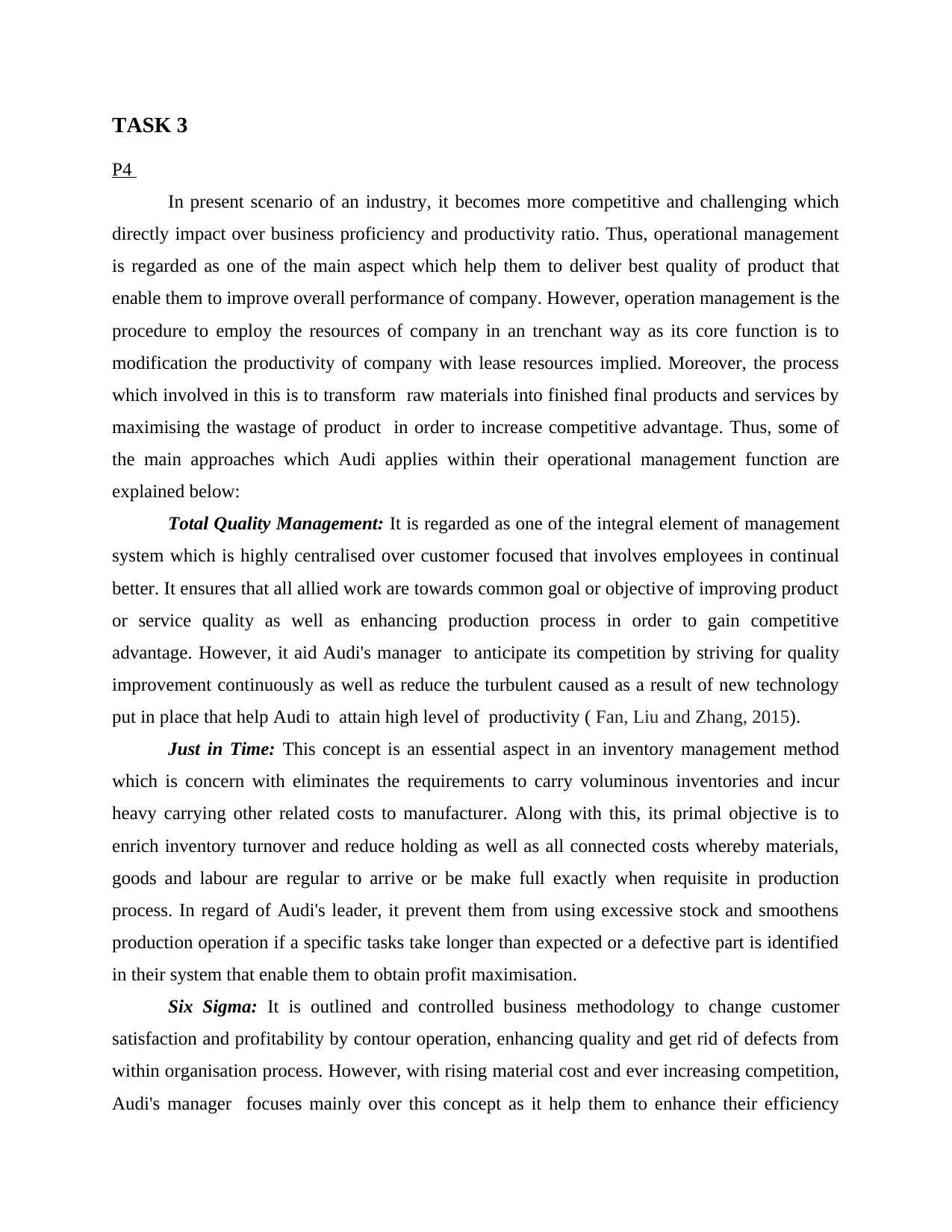
TASK 3
P4
In present scenario of an industry, it becomes more competitive and challenging which
directly impact over business proficiency and productivity ratio. Thus, operational management
is regarded as one of the main aspect which help them to deliver best quality of product that
enable them to improve overall performance of company. However, operation management is the
procedure to employ the resources of company in an trenchant way as its core function is to
modification the productivity of company with lease resources implied. Moreover, the process
which involved in this is to transform raw materials into finished final products and services by
maximising the wastage of product in order to increase competitive advantage. Thus, some of
the main approaches which Audi applies within their operational management function are
explained below:
Total Quality Management: It is regarded as one of the integral element of management
system which is highly centralised over customer focused that involves employees in continual
better. It ensures that all allied work are towards common goal or objective of improving product
or service quality as well as enhancing production process in order to gain competitive
advantage. However, it aid Audi's manager to anticipate its competition by striving for quality
improvement continuously as well as reduce the turbulent caused as a result of new technology
put in place that help Audi to attain high level of productivity ( Fan, Liu and Zhang, 2015).
Just in Time: This concept is an essential aspect in an inventory management method
which is concern with eliminates the requirements to carry voluminous inventories and incur
heavy carrying other related costs to manufacturer. Along with this, its primal objective is to
enrich inventory turnover and reduce holding as well as all connected costs whereby materials,
goods and labour are regular to arrive or be make full exactly when requisite in production
process. In regard of Audi's leader, it prevent them from using excessive stock and smoothens
production operation if a specific tasks take longer than expected or a defective part is identified
in their system that enable them to obtain profit maximisation.
Six Sigma: It is outlined and controlled business methodology to change customer
satisfaction and profitability by contour operation, enhancing quality and get rid of defects from
within organisation process. However, with rising material cost and ever increasing competition,
Audi's manager focuses mainly over this concept as it help them to enhance their efficiency
P4
In present scenario of an industry, it becomes more competitive and challenging which
directly impact over business proficiency and productivity ratio. Thus, operational management
is regarded as one of the main aspect which help them to deliver best quality of product that
enable them to improve overall performance of company. However, operation management is the
procedure to employ the resources of company in an trenchant way as its core function is to
modification the productivity of company with lease resources implied. Moreover, the process
which involved in this is to transform raw materials into finished final products and services by
maximising the wastage of product in order to increase competitive advantage. Thus, some of
the main approaches which Audi applies within their operational management function are
explained below:
Total Quality Management: It is regarded as one of the integral element of management
system which is highly centralised over customer focused that involves employees in continual
better. It ensures that all allied work are towards common goal or objective of improving product
or service quality as well as enhancing production process in order to gain competitive
advantage. However, it aid Audi's manager to anticipate its competition by striving for quality
improvement continuously as well as reduce the turbulent caused as a result of new technology
put in place that help Audi to attain high level of productivity ( Fan, Liu and Zhang, 2015).
Just in Time: This concept is an essential aspect in an inventory management method
which is concern with eliminates the requirements to carry voluminous inventories and incur
heavy carrying other related costs to manufacturer. Along with this, its primal objective is to
enrich inventory turnover and reduce holding as well as all connected costs whereby materials,
goods and labour are regular to arrive or be make full exactly when requisite in production
process. In regard of Audi's leader, it prevent them from using excessive stock and smoothens
production operation if a specific tasks take longer than expected or a defective part is identified
in their system that enable them to obtain profit maximisation.
Six Sigma: It is outlined and controlled business methodology to change customer
satisfaction and profitability by contour operation, enhancing quality and get rid of defects from
within organisation process. However, with rising material cost and ever increasing competition,
Audi's manager focuses mainly over this concept as it help them to enhance their efficiency
⊘ This is a preview!⊘
Do you want full access?
Subscribe today to unlock all pages.

Trusted by 1+ million students worldwide
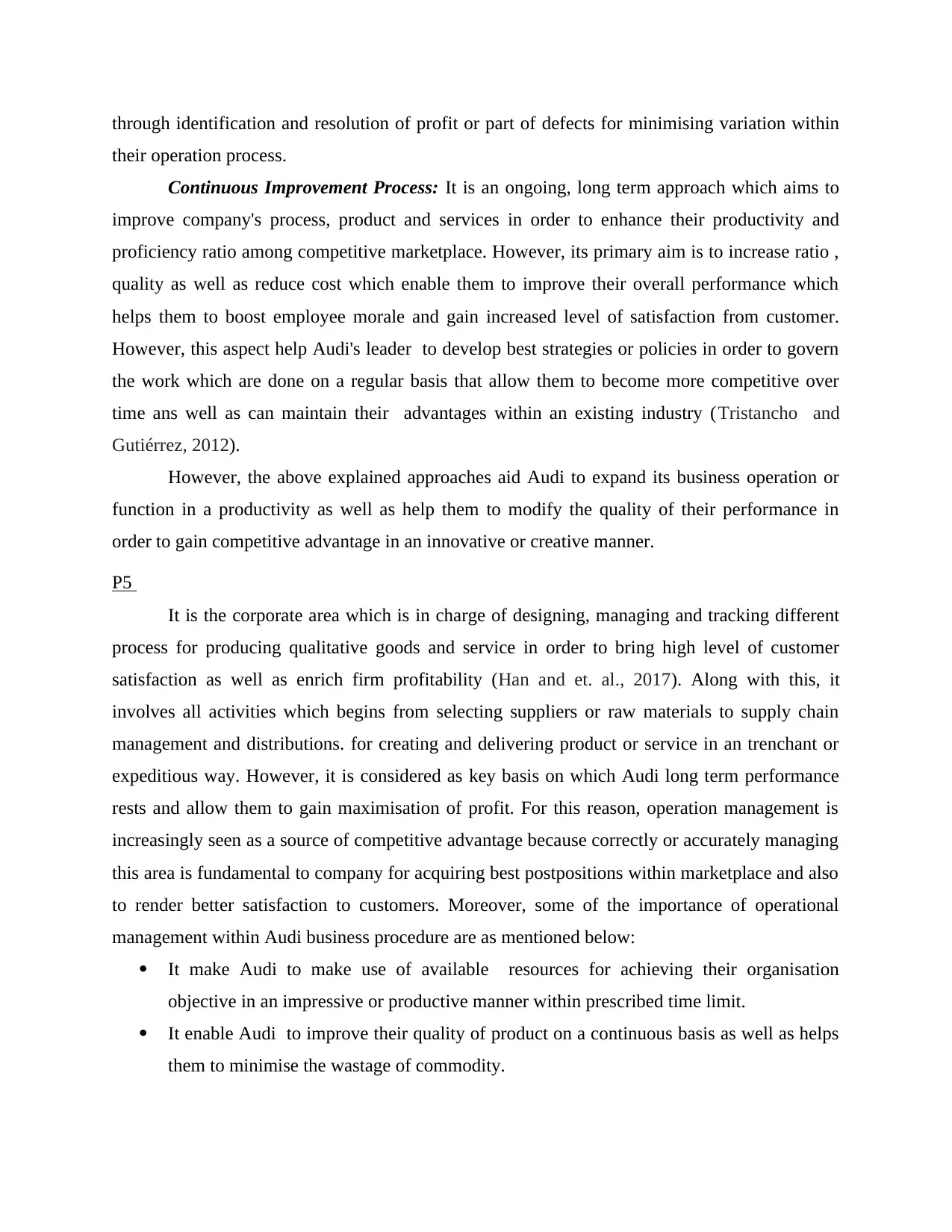
through identification and resolution of profit or part of defects for minimising variation within
their operation process.
Continuous Improvement Process: It is an ongoing, long term approach which aims to
improve company's process, product and services in order to enhance their productivity and
proficiency ratio among competitive marketplace. However, its primary aim is to increase ratio ,
quality as well as reduce cost which enable them to improve their overall performance which
helps them to boost employee morale and gain increased level of satisfaction from customer.
However, this aspect help Audi's leader to develop best strategies or policies in order to govern
the work which are done on a regular basis that allow them to become more competitive over
time ans well as can maintain their advantages within an existing industry (Tristancho and
Gutiérrez, 2012).
However, the above explained approaches aid Audi to expand its business operation or
function in a productivity as well as help them to modify the quality of their performance in
order to gain competitive advantage in an innovative or creative manner.
P5
It is the corporate area which is in charge of designing, managing and tracking different
process for producing qualitative goods and service in order to bring high level of customer
satisfaction as well as enrich firm profitability (Han and et. al., 2017). Along with this, it
involves all activities which begins from selecting suppliers or raw materials to supply chain
management and distributions. for creating and delivering product or service in an trenchant or
expeditious way. However, it is considered as key basis on which Audi long term performance
rests and allow them to gain maximisation of profit. For this reason, operation management is
increasingly seen as a source of competitive advantage because correctly or accurately managing
this area is fundamental to company for acquiring best postpositions within marketplace and also
to render better satisfaction to customers. Moreover, some of the importance of operational
management within Audi business procedure are as mentioned below:
It make Audi to make use of available resources for achieving their organisation
objective in an impressive or productive manner within prescribed time limit.
It enable Audi to improve their quality of product on a continuous basis as well as helps
them to minimise the wastage of commodity.
their operation process.
Continuous Improvement Process: It is an ongoing, long term approach which aims to
improve company's process, product and services in order to enhance their productivity and
proficiency ratio among competitive marketplace. However, its primary aim is to increase ratio ,
quality as well as reduce cost which enable them to improve their overall performance which
helps them to boost employee morale and gain increased level of satisfaction from customer.
However, this aspect help Audi's leader to develop best strategies or policies in order to govern
the work which are done on a regular basis that allow them to become more competitive over
time ans well as can maintain their advantages within an existing industry (Tristancho and
Gutiérrez, 2012).
However, the above explained approaches aid Audi to expand its business operation or
function in a productivity as well as help them to modify the quality of their performance in
order to gain competitive advantage in an innovative or creative manner.
P5
It is the corporate area which is in charge of designing, managing and tracking different
process for producing qualitative goods and service in order to bring high level of customer
satisfaction as well as enrich firm profitability (Han and et. al., 2017). Along with this, it
involves all activities which begins from selecting suppliers or raw materials to supply chain
management and distributions. for creating and delivering product or service in an trenchant or
expeditious way. However, it is considered as key basis on which Audi long term performance
rests and allow them to gain maximisation of profit. For this reason, operation management is
increasingly seen as a source of competitive advantage because correctly or accurately managing
this area is fundamental to company for acquiring best postpositions within marketplace and also
to render better satisfaction to customers. Moreover, some of the importance of operational
management within Audi business procedure are as mentioned below:
It make Audi to make use of available resources for achieving their organisation
objective in an impressive or productive manner within prescribed time limit.
It enable Audi to improve their quality of product on a continuous basis as well as helps
them to minimise the wastage of commodity.
Paraphrase This Document
Need a fresh take? Get an instant paraphrase of this document with our AI Paraphraser
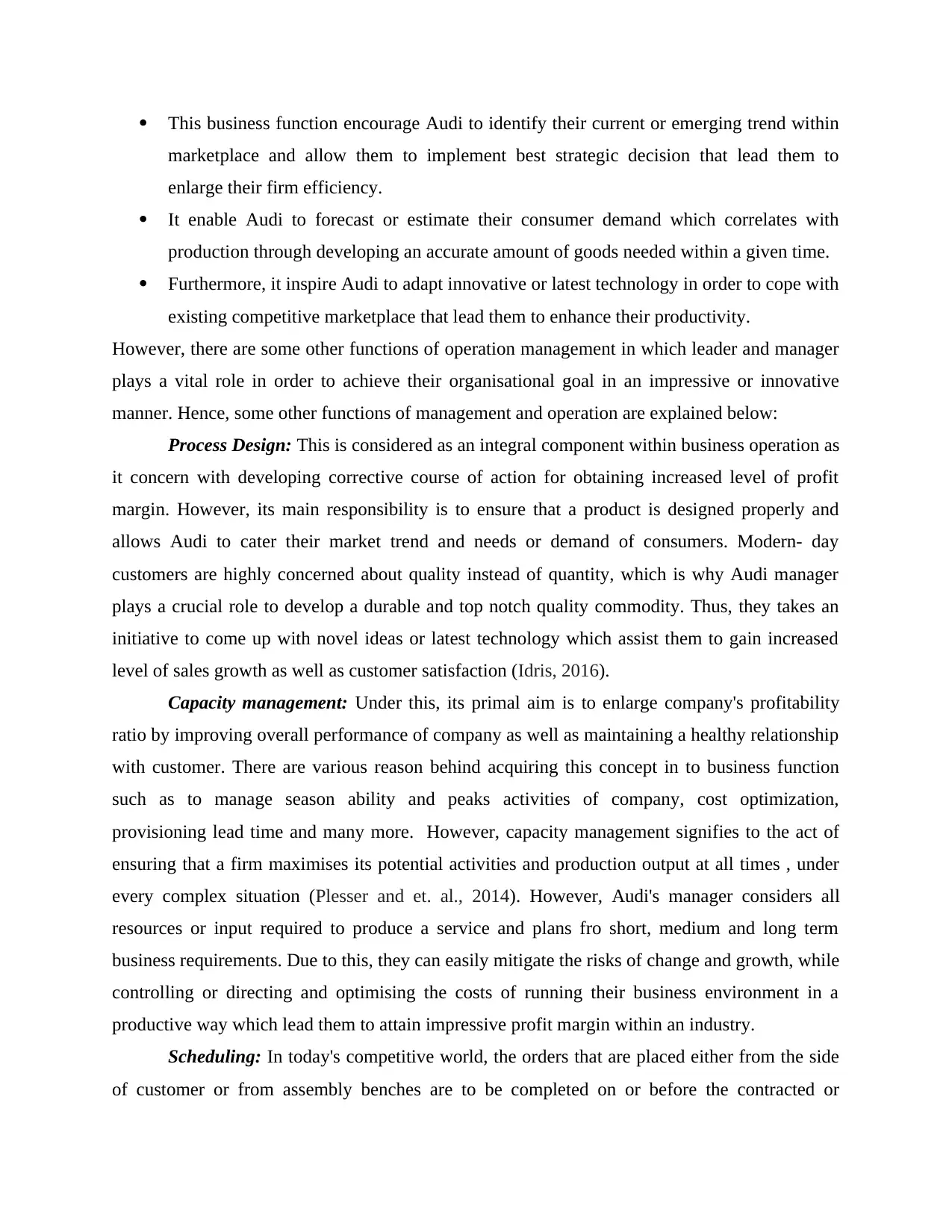
This business function encourage Audi to identify their current or emerging trend within
marketplace and allow them to implement best strategic decision that lead them to
enlarge their firm efficiency.
It enable Audi to forecast or estimate their consumer demand which correlates with
production through developing an accurate amount of goods needed within a given time.
Furthermore, it inspire Audi to adapt innovative or latest technology in order to cope with
existing competitive marketplace that lead them to enhance their productivity.
However, there are some other functions of operation management in which leader and manager
plays a vital role in order to achieve their organisational goal in an impressive or innovative
manner. Hence, some other functions of management and operation are explained below:
Process Design: This is considered as an integral component within business operation as
it concern with developing corrective course of action for obtaining increased level of profit
margin. However, its main responsibility is to ensure that a product is designed properly and
allows Audi to cater their market trend and needs or demand of consumers. Modern- day
customers are highly concerned about quality instead of quantity, which is why Audi manager
plays a crucial role to develop a durable and top notch quality commodity. Thus, they takes an
initiative to come up with novel ideas or latest technology which assist them to gain increased
level of sales growth as well as customer satisfaction (Idris, 2016).
Capacity management: Under this, its primal aim is to enlarge company's profitability
ratio by improving overall performance of company as well as maintaining a healthy relationship
with customer. There are various reason behind acquiring this concept in to business function
such as to manage season ability and peaks activities of company, cost optimization,
provisioning lead time and many more. However, capacity management signifies to the act of
ensuring that a firm maximises its potential activities and production output at all times , under
every complex situation (Plesser and et. al., 2014). However, Audi's manager considers all
resources or input required to produce a service and plans fro short, medium and long term
business requirements. Due to this, they can easily mitigate the risks of change and growth, while
controlling or directing and optimising the costs of running their business environment in a
productive way which lead them to attain impressive profit margin within an industry.
Scheduling: In today's competitive world, the orders that are placed either from the side
of customer or from assembly benches are to be completed on or before the contracted or
marketplace and allow them to implement best strategic decision that lead them to
enlarge their firm efficiency.
It enable Audi to forecast or estimate their consumer demand which correlates with
production through developing an accurate amount of goods needed within a given time.
Furthermore, it inspire Audi to adapt innovative or latest technology in order to cope with
existing competitive marketplace that lead them to enhance their productivity.
However, there are some other functions of operation management in which leader and manager
plays a vital role in order to achieve their organisational goal in an impressive or innovative
manner. Hence, some other functions of management and operation are explained below:
Process Design: This is considered as an integral component within business operation as
it concern with developing corrective course of action for obtaining increased level of profit
margin. However, its main responsibility is to ensure that a product is designed properly and
allows Audi to cater their market trend and needs or demand of consumers. Modern- day
customers are highly concerned about quality instead of quantity, which is why Audi manager
plays a crucial role to develop a durable and top notch quality commodity. Thus, they takes an
initiative to come up with novel ideas or latest technology which assist them to gain increased
level of sales growth as well as customer satisfaction (Idris, 2016).
Capacity management: Under this, its primal aim is to enlarge company's profitability
ratio by improving overall performance of company as well as maintaining a healthy relationship
with customer. There are various reason behind acquiring this concept in to business function
such as to manage season ability and peaks activities of company, cost optimization,
provisioning lead time and many more. However, capacity management signifies to the act of
ensuring that a firm maximises its potential activities and production output at all times , under
every complex situation (Plesser and et. al., 2014). However, Audi's manager considers all
resources or input required to produce a service and plans fro short, medium and long term
business requirements. Due to this, they can easily mitigate the risks of change and growth, while
controlling or directing and optimising the costs of running their business environment in a
productive way which lead them to attain impressive profit margin within an industry.
Scheduling: In today's competitive world, the orders that are placed either from the side
of customer or from assembly benches are to be completed on or before the contracted or
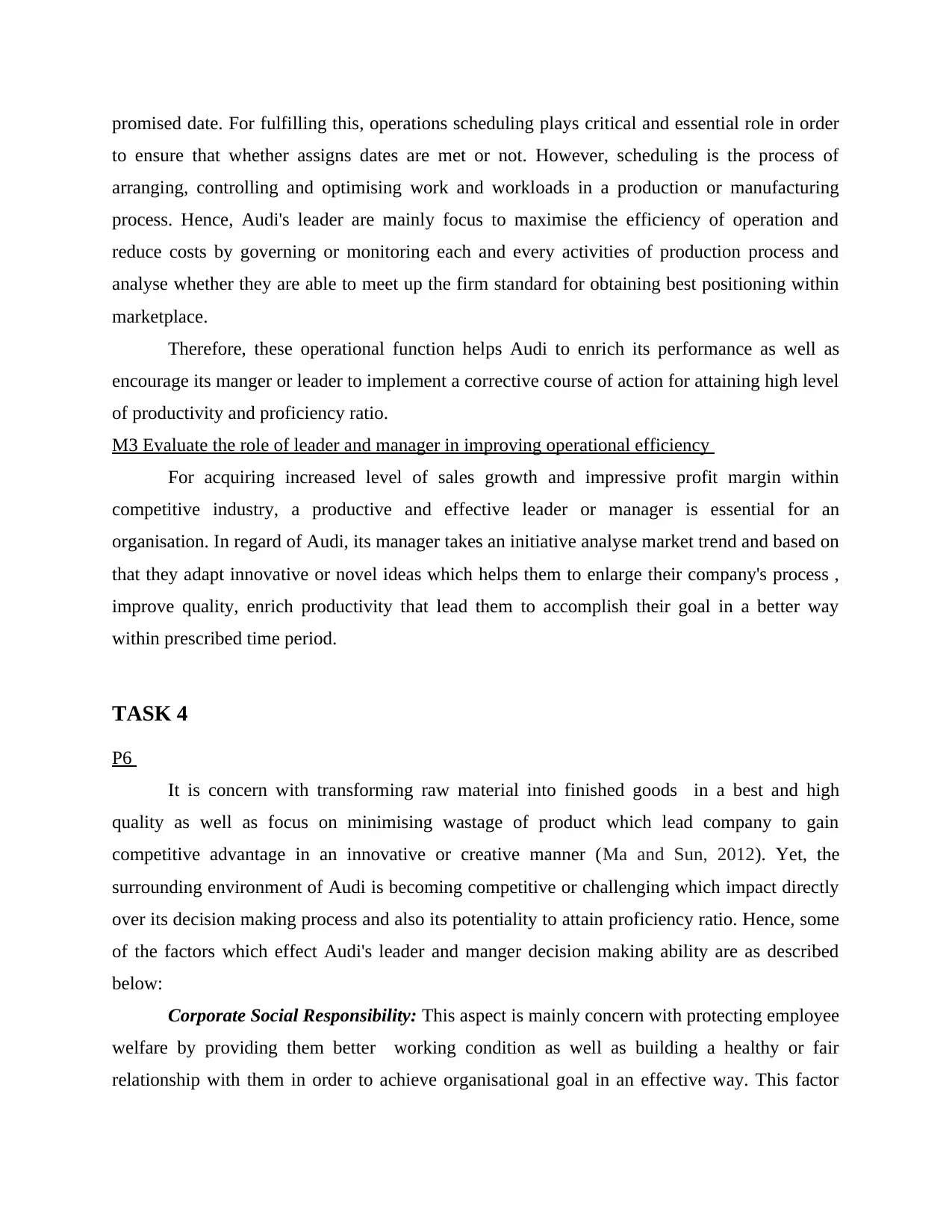
promised date. For fulfilling this, operations scheduling plays critical and essential role in order
to ensure that whether assigns dates are met or not. However, scheduling is the process of
arranging, controlling and optimising work and workloads in a production or manufacturing
process. Hence, Audi's leader are mainly focus to maximise the efficiency of operation and
reduce costs by governing or monitoring each and every activities of production process and
analyse whether they are able to meet up the firm standard for obtaining best positioning within
marketplace.
Therefore, these operational function helps Audi to enrich its performance as well as
encourage its manger or leader to implement a corrective course of action for attaining high level
of productivity and proficiency ratio.
M3 Evaluate the role of leader and manager in improving operational efficiency
For acquiring increased level of sales growth and impressive profit margin within
competitive industry, a productive and effective leader or manager is essential for an
organisation. In regard of Audi, its manager takes an initiative analyse market trend and based on
that they adapt innovative or novel ideas which helps them to enlarge their company's process ,
improve quality, enrich productivity that lead them to accomplish their goal in a better way
within prescribed time period.
TASK 4
P6
It is concern with transforming raw material into finished goods in a best and high
quality as well as focus on minimising wastage of product which lead company to gain
competitive advantage in an innovative or creative manner (Ma and Sun, 2012). Yet, the
surrounding environment of Audi is becoming competitive or challenging which impact directly
over its decision making process and also its potentiality to attain proficiency ratio. Hence, some
of the factors which effect Audi's leader and manger decision making ability are as described
below:
Corporate Social Responsibility: This aspect is mainly concern with protecting employee
welfare by providing them better working condition as well as building a healthy or fair
relationship with them in order to achieve organisational goal in an effective way. This factor
to ensure that whether assigns dates are met or not. However, scheduling is the process of
arranging, controlling and optimising work and workloads in a production or manufacturing
process. Hence, Audi's leader are mainly focus to maximise the efficiency of operation and
reduce costs by governing or monitoring each and every activities of production process and
analyse whether they are able to meet up the firm standard for obtaining best positioning within
marketplace.
Therefore, these operational function helps Audi to enrich its performance as well as
encourage its manger or leader to implement a corrective course of action for attaining high level
of productivity and proficiency ratio.
M3 Evaluate the role of leader and manager in improving operational efficiency
For acquiring increased level of sales growth and impressive profit margin within
competitive industry, a productive and effective leader or manager is essential for an
organisation. In regard of Audi, its manager takes an initiative analyse market trend and based on
that they adapt innovative or novel ideas which helps them to enlarge their company's process ,
improve quality, enrich productivity that lead them to accomplish their goal in a better way
within prescribed time period.
TASK 4
P6
It is concern with transforming raw material into finished goods in a best and high
quality as well as focus on minimising wastage of product which lead company to gain
competitive advantage in an innovative or creative manner (Ma and Sun, 2012). Yet, the
surrounding environment of Audi is becoming competitive or challenging which impact directly
over its decision making process and also its potentiality to attain proficiency ratio. Hence, some
of the factors which effect Audi's leader and manger decision making ability are as described
below:
Corporate Social Responsibility: This aspect is mainly concern with protecting employee
welfare by providing them better working condition as well as building a healthy or fair
relationship with them in order to achieve organisational goal in an effective way. This factor
⊘ This is a preview!⊘
Do you want full access?
Subscribe today to unlock all pages.

Trusted by 1+ million students worldwide
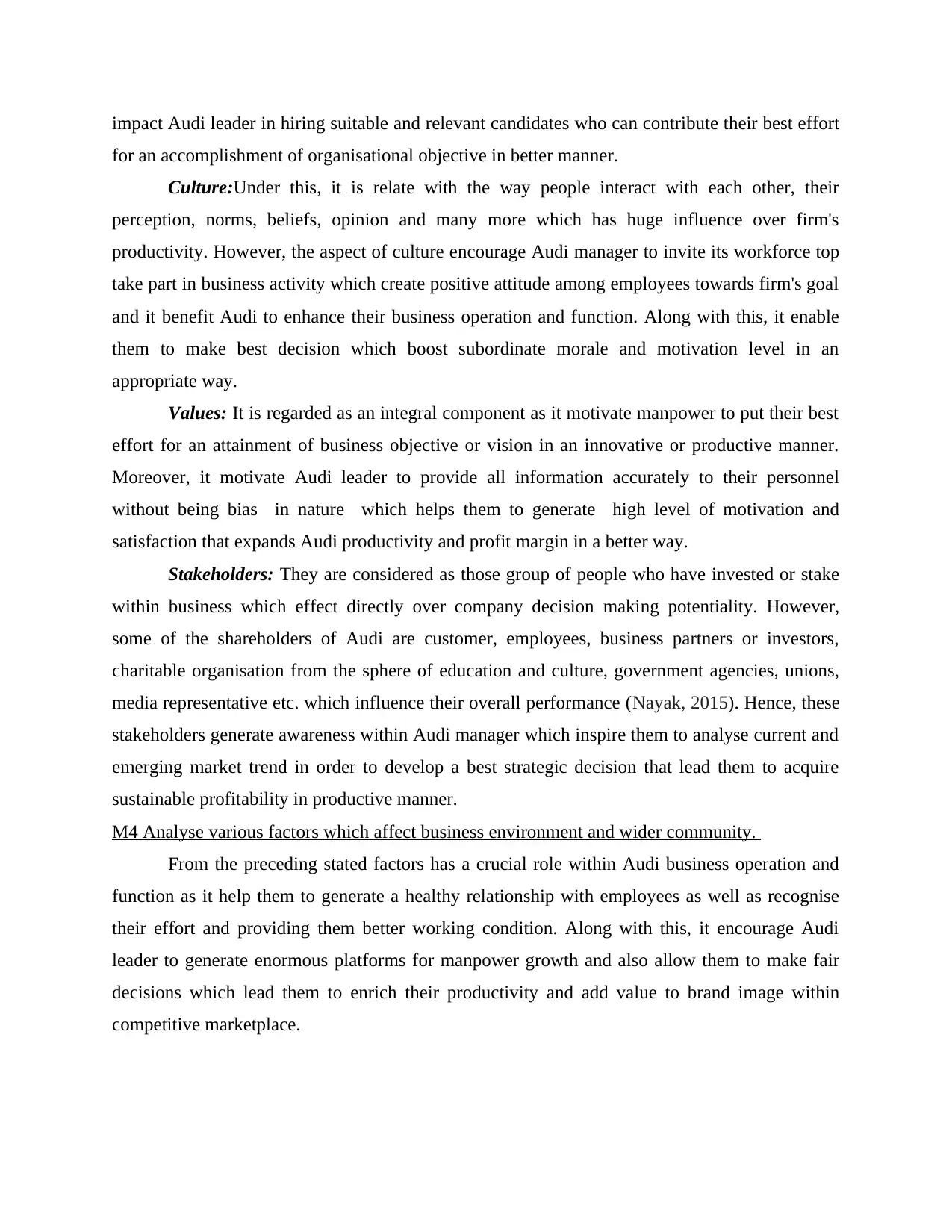
impact Audi leader in hiring suitable and relevant candidates who can contribute their best effort
for an accomplishment of organisational objective in better manner.
Culture:Under this, it is relate with the way people interact with each other, their
perception, norms, beliefs, opinion and many more which has huge influence over firm's
productivity. However, the aspect of culture encourage Audi manager to invite its workforce top
take part in business activity which create positive attitude among employees towards firm's goal
and it benefit Audi to enhance their business operation and function. Along with this, it enable
them to make best decision which boost subordinate morale and motivation level in an
appropriate way.
Values: It is regarded as an integral component as it motivate manpower to put their best
effort for an attainment of business objective or vision in an innovative or productive manner.
Moreover, it motivate Audi leader to provide all information accurately to their personnel
without being bias in nature which helps them to generate high level of motivation and
satisfaction that expands Audi productivity and profit margin in a better way.
Stakeholders: They are considered as those group of people who have invested or stake
within business which effect directly over company decision making potentiality. However,
some of the shareholders of Audi are customer, employees, business partners or investors,
charitable organisation from the sphere of education and culture, government agencies, unions,
media representative etc. which influence their overall performance (Nayak, 2015). Hence, these
stakeholders generate awareness within Audi manager which inspire them to analyse current and
emerging market trend in order to develop a best strategic decision that lead them to acquire
sustainable profitability in productive manner.
M4 Analyse various factors which affect business environment and wider community.
From the preceding stated factors has a crucial role within Audi business operation and
function as it help them to generate a healthy relationship with employees as well as recognise
their effort and providing them better working condition. Along with this, it encourage Audi
leader to generate enormous platforms for manpower growth and also allow them to make fair
decisions which lead them to enrich their productivity and add value to brand image within
competitive marketplace.
for an accomplishment of organisational objective in better manner.
Culture:Under this, it is relate with the way people interact with each other, their
perception, norms, beliefs, opinion and many more which has huge influence over firm's
productivity. However, the aspect of culture encourage Audi manager to invite its workforce top
take part in business activity which create positive attitude among employees towards firm's goal
and it benefit Audi to enhance their business operation and function. Along with this, it enable
them to make best decision which boost subordinate morale and motivation level in an
appropriate way.
Values: It is regarded as an integral component as it motivate manpower to put their best
effort for an attainment of business objective or vision in an innovative or productive manner.
Moreover, it motivate Audi leader to provide all information accurately to their personnel
without being bias in nature which helps them to generate high level of motivation and
satisfaction that expands Audi productivity and profit margin in a better way.
Stakeholders: They are considered as those group of people who have invested or stake
within business which effect directly over company decision making potentiality. However,
some of the shareholders of Audi are customer, employees, business partners or investors,
charitable organisation from the sphere of education and culture, government agencies, unions,
media representative etc. which influence their overall performance (Nayak, 2015). Hence, these
stakeholders generate awareness within Audi manager which inspire them to analyse current and
emerging market trend in order to develop a best strategic decision that lead them to acquire
sustainable profitability in productive manner.
M4 Analyse various factors which affect business environment and wider community.
From the preceding stated factors has a crucial role within Audi business operation and
function as it help them to generate a healthy relationship with employees as well as recognise
their effort and providing them better working condition. Along with this, it encourage Audi
leader to generate enormous platforms for manpower growth and also allow them to make fair
decisions which lead them to enrich their productivity and add value to brand image within
competitive marketplace.
Paraphrase This Document
Need a fresh take? Get an instant paraphrase of this document with our AI Paraphraser
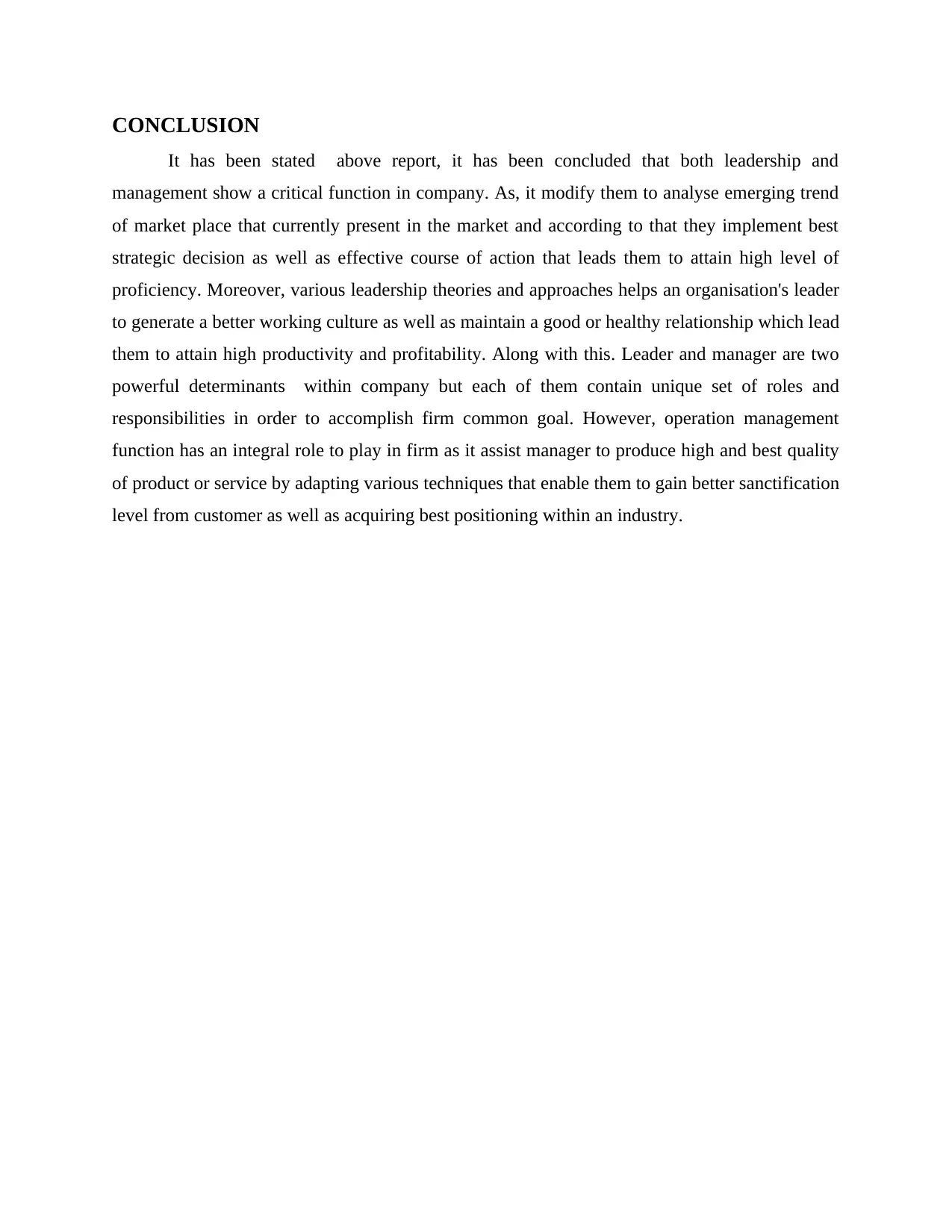
CONCLUSION
It has been stated above report, it has been concluded that both leadership and
management show a critical function in company. As, it modify them to analyse emerging trend
of market place that currently present in the market and according to that they implement best
strategic decision as well as effective course of action that leads them to attain high level of
proficiency. Moreover, various leadership theories and approaches helps an organisation's leader
to generate a better working culture as well as maintain a good or healthy relationship which lead
them to attain high productivity and profitability. Along with this. Leader and manager are two
powerful determinants within company but each of them contain unique set of roles and
responsibilities in order to accomplish firm common goal. However, operation management
function has an integral role to play in firm as it assist manager to produce high and best quality
of product or service by adapting various techniques that enable them to gain better sanctification
level from customer as well as acquiring best positioning within an industry.
It has been stated above report, it has been concluded that both leadership and
management show a critical function in company. As, it modify them to analyse emerging trend
of market place that currently present in the market and according to that they implement best
strategic decision as well as effective course of action that leads them to attain high level of
proficiency. Moreover, various leadership theories and approaches helps an organisation's leader
to generate a better working culture as well as maintain a good or healthy relationship which lead
them to attain high productivity and profitability. Along with this. Leader and manager are two
powerful determinants within company but each of them contain unique set of roles and
responsibilities in order to accomplish firm common goal. However, operation management
function has an integral role to play in firm as it assist manager to produce high and best quality
of product or service by adapting various techniques that enable them to gain better sanctification
level from customer as well as acquiring best positioning within an industry.
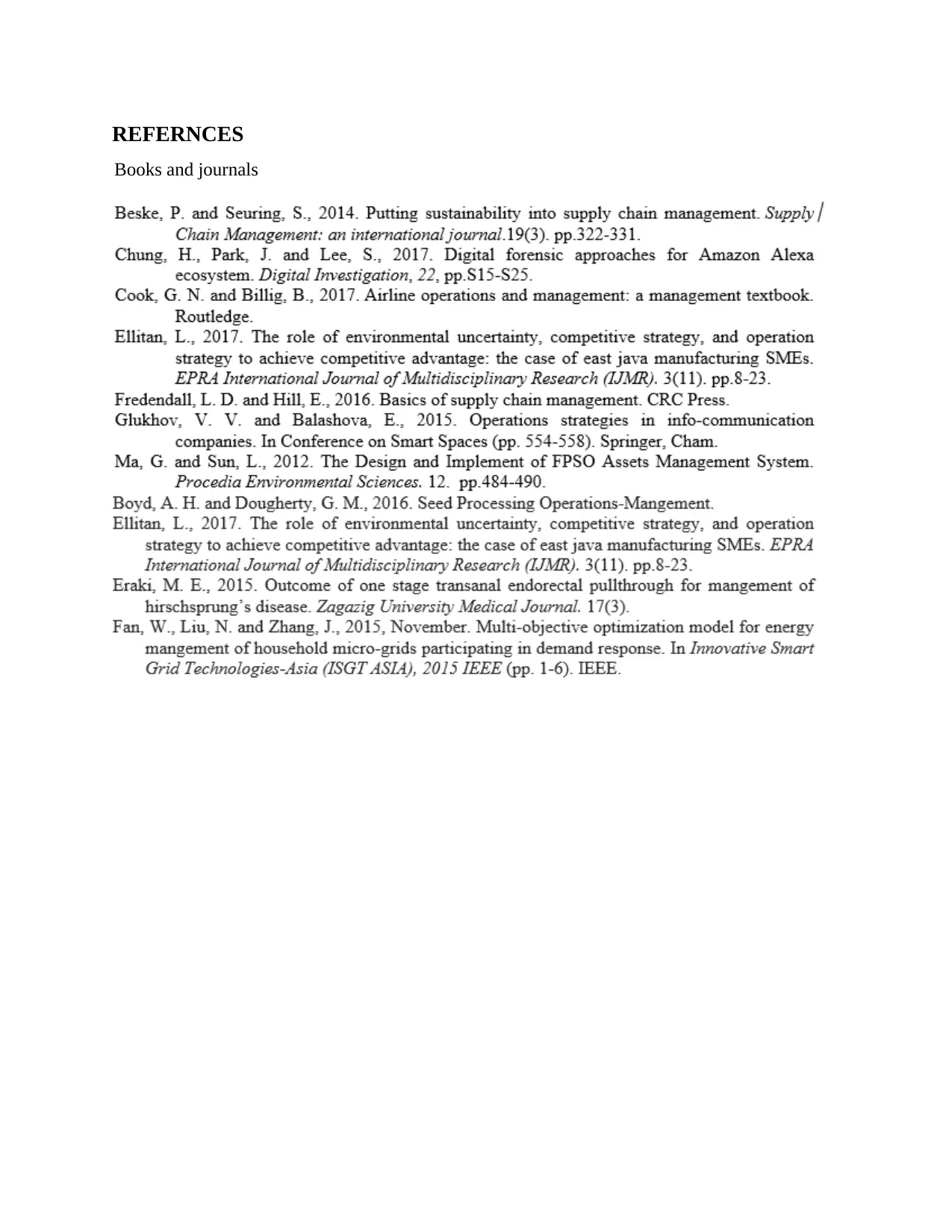
REFERNCES
Books and journals
Books and journals
⊘ This is a preview!⊘
Do you want full access?
Subscribe today to unlock all pages.

Trusted by 1+ million students worldwide
1 out of 13
Related Documents
Your All-in-One AI-Powered Toolkit for Academic Success.
+13062052269
info@desklib.com
Available 24*7 on WhatsApp / Email
![[object Object]](/_next/static/media/star-bottom.7253800d.svg)
Unlock your academic potential
Copyright © 2020–2025 A2Z Services. All Rights Reserved. Developed and managed by ZUCOL.





